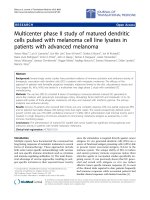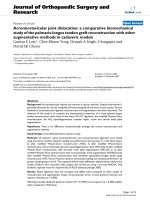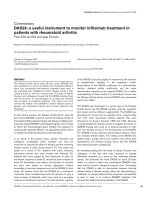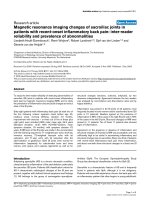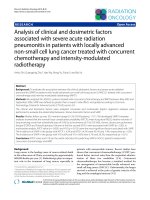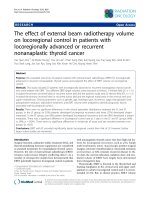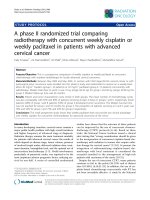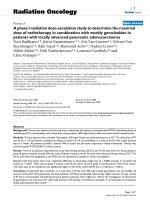A phase II study of weekly irinotecan in patients with locally advanced or metastatic HER2- negative breast cancer and increased copy numbers of the topoisomerase 1 (TOP1) gene: A study
Bạn đang xem bản rút gọn của tài liệu. Xem và tải ngay bản đầy đủ của tài liệu tại đây (338.06 KB, 5 trang )
Kümler et al. BMC Cancer (2015) 15:78
DOI 10.1186/s12885-015-1072-9
STUDY PROTOCOL
Open Access
A phase II study of weekly irinotecan in patients
with locally advanced or metastatic HER2- negative
breast cancer and increased copy numbers of the
topoisomerase 1 (TOP1) gene: a study protocol
Iben Kümler1*, Eva Balslev2, Jan Stenvang3, Nils Brünner3 and Dorte Nielsen1
Abstract
Background: About 20% of patients with primary breast cancer develop metastatic disease during the course of
the disease. At this point the disease is considered incurable and thus treatment is aimed at palliation and life
prolongation. As many patients will have received both an anthracycline and a taxane in the adjuvant setting,
treatment options for metastatic breast cancer are limited. Furthermore response rates for the most commonly
used drugs range from around 30% to 12% . Thus new treatment options are needed and preferably coupled to
biomarkers predictive of response. Irinotecan is a topoisomerase 1 inhibitor used for decades for the treatment of
colorectal cancer. Four studies have investigated the efficacy of irinotecan monotherapy in breast cancer and all
have included non-biomarker selected patients. In these studies response rates for irinotecan ranged from 5%-23%
and are thus comparable to response rates obtained with drugs commonly used in the metastatic setting. If a
predictive biomarker could be identified for irinotecan, response rates might be even higher.
Methods/Design: This multi-centre phase II single arm trial was designed to investigate if patients with metastatic
breast cancer and increased expression of the topoisomerase 1 gene have a high likelihood of obtaining a clinical
benefit from treatment with irinotecan. Trial recruitment is two-staged as 19 patients are planned to participate in
the first part. If less than 7 patients have clinical benefit the trial stops, if more than 7 patients have clinical benefit
a total of 40 patients will be included.
Discussion: This ongoing trial is the first to prospectively test copy number of the topoisomerase I gene as a
predictive biomarker of response to irinotecan.
Trial registration: EudraCT number 2012-002348-26.
Background
Breast cancer (BC) is the most common malignancy among
women in the western world. Despite improvements in the
adjuvant treatment around 20% of patients with primary
BC will develop recurrence [1]. Metastatic breast cancer
(mBC) is considered incurable in the vast majority of
cases and thus treatment is aimed at palliation and life
prolongation. Depending on estrogen (ER) and human
epidermal receptor 2 (HER2) status, treatment options
include a handful of cytostatic drugs among which the
* Correspondence:
1
Department of Oncology, Herlev University Hospital, Copenhagen, Denmark
Full list of author information is available at the end of the article
anthracyclines and the taxanes are the most efficient.
Given as first-line treatment to chemo-naïve patients,
anthracyclines have shown response rates (RR) of up
to 70% [2,3]. Among patients exposed to adjuvant
non-anthracycline containing chemotherapy RRs are
around 50% [2,4,5], while these figures drop to around
36%-38% when given to patiets previopusly treated with
anthracyclines in the adjuvant setting [6]. Taxanes have
shown RRs of approximately 40% in the first-line setting
[7,8], dropping to 26-30% as second-line treatment [9].
The proportion of patients with primary BC receiving
some kind of adjuvant therapy has increased during the
past 20 years. Although not all patients receive adjuvant
chemotherapy still a growing number of patients will have
© 2015 Kümler et al.; licensee BioMed Central. This is an Open Access article distributed under the terms of the Creative
Commons Attribution License ( which permits unrestricted use, distribution, and
reproduction in any medium, provided the original work is properly credited. The Creative Commons Public Domain
Dedication waiver ( applies to the data made available in this article,
unless otherwise stated.
Kümler et al. BMC Cancer (2015) 15:78
been exposed to both anthracyclines and taxanes at the
time of recurrence. In these cases or following relapse on
either treatment capecitabine or vinorelbine will often be
considered as rational treatment options. Although no
specific recommendations are given in international
guidelines regarding the choice of drug for second- or
third line treatment, unanimously guidelines recommend
sequential monotherapy [10,11]. Capecitabine has shown
RRs in the range 20% to 30% as first-line treatment
[12-15] and vinorelbine has showed RRs of 15%-25% when
given as second- or third line treatment [16-18]. Eribulin a
new microtubule inhibitor has shown RRs of 12% in heavily
pre-treated patients whereas the old drug gemcitabine is
effective in 20% to 37% of patients depending on line of
treatment [19-22]. From these figures it is evident that the
majority of patients are deriving no benefit from treatment
with these agents but nevertheless suffer the associated side
effects. New individualized treatment options are needed
for these patients. In order to improve the therapeutic
index, preferably all drugs should be coupled to biomarkers
predictable of response to the treatment. This is already in
use with anti-ER and anti-HER2 treatments but for
the cytotoxic chemotherapeutics no such biomarkers
are developed to a stage where they can be implemented
in daily clinical breast cancer management.
Irinotecan
Irinotecan is a topoisomerase 1 (Top 1) inhibitor acting
as a pro-drug and is enzymatically converted to the
active metabolite SN-38 [23]. Like other Top 1 inhibitors
it exerts its mechanism of action through binding to the
Top 1-DNA complex during replication and transcription and thereby maintaining single-strand DNA breaks,
ultimately resulting in the formation of double-stranded
DNA breaks, which causes cell death [24]. Irinotecan
has been used in the treatment of colorectal cancer
(CRC) for decades. Several studies have tried to establish
a correlation between expression of the TOP1 gene or
protein and response to irinotecan. Results have been
conflicting and study methods have varied significantly
making comparisons of the various studies quite difficult.
Today no standardized methods for detecting Top 1
protein expression have been established and no validated
scoring systems exists for neither gene nor protein expressions. Nevertheless, some studies have found a correlation
between TOP1 gene as well as protein expressions and
response to irinotecan [25,26]. From our laboratory, we
have published a significant correlation between TOP1
gene copy number and sensitivity to SN38 in 10 human
CRC cell lines [27] and very recently we published on the
association between TOP1 gene copy number and benefit
from irinotecan treatment in metastatic CRC [28]. These
studies suggest that TOP1 gene copy number determinations can be used as predictive biomarker for irinotecan
Page 2 of 5
treatment in CRC patients. However, additional clinical
studies are need to establish TOP1 gene copy number as
an irinotecan predictive biomarker in CRC patients and
further as a predictive biomarker for irinotecan treatment
of BC patients.
Irinotecan in BC
Few studies on irinotecan in BC have been published. A
systematic review identified 19 trials [29]. No phase III
or randomized phase II trials have been published except
for trials randomizing between different dosing schedules
of irinotecan monotherapy [30,31] and only one study
included more than 100 patients [30]. All trials included
unselected patients and prior treatment with an anthracycline and/or a taxane was required in all but one study.
Four studies investigated irinotecan as monotherapy.
Treatment schedules varied among the studies as
three studies investigated intravenous irinotecan given
either weekly for 4 weeks followed by two weeks break,
given every other week or given every third week
[30,32,33]. The last study investigated oral irinotecan [31].
RRs ranged from 5% to 23% with the higher response rate
found in a study by Perez et al. in which two different
schedules of irinotecan were compared [29]. One hundred
and three women were included and a maximum of two
prior treatment regimens for mBC was allowed. Patients
received either weekly irinotecan for four weeks followed
by two weeks break (q 42d) or irinotecan every 3 weeks
(q 21d). RR in the q 42d arm was 23% (CI 13%-37%)
compared to 14% (CI 6-26%) in the q 21d arm. Median response duration was 4.9 months for patients in the q 42d
arm compared to 4.2 in the q 21d arm and median
OS was 9.7 months (CI 8.0-14.2 months) and 8.6 (CI
7.0-12.3 months), respectively [30]. The two remaining
studies on intravenously irinotecan both showed RR of
approximately 6% [32,33]. However, one study was a
retrospective study of 20 patients previously treated with
both an anthracycline and docetaxel [33] while the other
study included 18 patients of which 72% had received
three or more chemotherapy regimens for metastatic
disease [32]. The last study was on oral irinotecan [31]. A
more recent study investigated the new polymer conjugate
of irinotecan; etirinotecan (NKTR-102). A total of 70
patients were included with a maximum of two prior
treatment regimens for metastatic disease. Etirinotecan
was administered every 14 days (q14d) or every 21 days
(q21d). Progression free survival (PFS) was 3.5 months
in the q14d arm and 5.3 months in the q21d arm and
overall survival (OS) was 8.8 months and 13.1 months,
respectively. However, the RR of 32% was superior in the
q14d arm compared to the RR of 26% in the q21d
arm [34]. Thus RRs for irinotecan are comparable to those
found for taxanes used in second-line and to vinorelbine,
gemcitabine and eriblulin used in second- or later lines of
Kümler et al. BMC Cancer (2015) 15:78
treatment. However, as all of the previously conducted
studies with irinotecan in BC have included unselected
patients, the RR for irinotecan could possibly be higher if
a biomarker for response could be identified.
Topoisomerase 1 in BC
In order to make TOP1 a clinically relevant biomarker
for response to irinotecan, overexpression of the protein
would have to occur in a fairly large part of patients.
Only one published study has investigated the frequency
of Top 1 protein expression in BC. A small study including
samples from 22 primary BC reported increased expression
of Top 1 by immunohistochemistry (IHC) in 41% of the
investigated samples indicating that this aberration is quite
common in BC [35].
Conclusively, the available data on irinotecan for the
treatment of mBC are very scant and insufficient but
they all point to a potential role of this drug in treatment
of mBC patient with prior taxane and anthracycline
treatment. An objective RR to irinotecan treatment in
such patients appears to be approximately 25-30% and
therefore calls for identification of irinotecan predictive
biomarkers to avoid unnecessary drug induced site effects
in non-responsive patients.
The aim of the below presented clinical study is to
investigate if patients with mBC and increased gene
expression of TOP 1 in their cancer cells have a high
likelihood of obtaining a clinical benefit when treated
with irinotecan.
Page 3 of 5
defined as ≥ 4 gene copy numbers or a TOP1/CEN-20
ratio of ≥2.
Exclusion criteria include current or previous other
malignant diseases except basal cell carcinoma of the
skin and carcinoma in situ cervices uteri, cytotoxic or
experimental therapy within 14 days before enrolment
and evidence of active CNS metastases. Furthermore,
patients who are pregnant, breastfeeding or of childbearing
potential and not using adequate non-hormonal contraception will be excluded as will patients with active infections
or other severe concomitant medical conditions that may
hinder the patient’s opportunity of receiving treatment
according to the protocol.
Treatment
Patients are treated with irinotecan 75 mg/m2 weekly for
three weeks followed by two weeks break. CT scans are
performed prior to initiation of treatment and then every
6 weeks. Treatment is continued until progression or
unacceptable toxicity. Toxicity is assessed prior to every
treatment according to the common terminology criteria
for adverse events (CTCAE, version 4.0).
Ethics
The trial was approved by the Ethical Committee of
Region Hovedstaden (H-1-2012-066) as well as by the
Danish Medical Authority (EudraCT number 2012002348-26) and the Danish Data Protection Agency
(2007-58-0015 /HEH.750.24-64).
Methods/Design
Study objectives
Design
The primary end point of this study is clinical benefit
rate (CBR) defined as the fraction of patients receiving
clinical benefit (CB) in the form of complete or partial
response or stable disease ≥ 4 months according to
RECIST 1.1. Secondary endpoints include PFS, OS and
toxicity.
This study is a prospective non-randomized phase II trial
of weekly irinotecan in patients with locally advanced or
metastatic HER2- negative BC and increased copy
numbers of the TOP1 gene in their cancer cells.
Participants
The study is a multi-centre trial including 7 oncologic
centres in Denmark. To be eligible for inclusion patients
must provide written informed consent before any study
related procedures. All patients must be above the
age of 18, have performance status 0–2 according to
the Eastern Cooperative Oncology Group (ECOG)
and a life expectancy of ≥ 3 months. Furthermore, patients
should have HER2-negative mBC and measurable disease
according to RECIST 1.1 and with a maximum of 4
prior chemotherapy regimens for metastatic disease;
all previous endocrine treatment is allowed. A neutrophil count of ≥ 1.5 x 109 and platelets ≥ 100 x 109 are
required as well as adequate liver function. Finally,
patients should have increased copy number of the
TOP1 gene in either their primary or metastatic lesion
Statistics
Number of patients in the study is based on Simon’s
two-stage minimax design. Intention-to-treat analysis
will be performed. By using a significance level of 0.05
(a = 0.05) and a power of 80% (b = 0.20) 19 patients
should be included in the first step in order to find a
CBR of at least 30%. Further inclusion ceases if less than
7/19 patients show CB. If 7 or more show CB another
20 patients will be included. If more than a total of 16
patients achieve CB the hypothesis is satisfied.
PFS and OS will be estimated using the Kaplan-Meier
method and compared with a log-rank test. Categorical
variables are indicated by a median followed by the span.
A significance level of 5% will be used. PFS and OS will
be assessed in the evaluable population.
Kümler et al. BMC Cancer (2015) 15:78
Methods
TOP1 gene copy assessment
Prior to inclusion tissue samples from primary and/or
metastatic lesions are investigated for TOP1 and CEN20
gene copy numbers. Whenever possible, tissue microarrays
(TMA) are constructed, using Advanced Tissue Arrayer,
ATA-100 (Chemicon International, Temecula, CA, USA).
Four 1 mm cores cut at 3 μm are obtained from each
biopsy. Samples containing small amounts of tumor
tissue or otherwise not suited for TMA construction have
full sections made. FISH using a TOP1/Centromere-20
(CEN-20) probe [27,36] is used to evaluate the TOP1/
CEN-20 ratio as well as the absolute number of TOP1
gene copies per cell.
A total of 60 signals are counted per tissue sample.
If a TOP1/CEN-20 ratio ≥2 or an absolute gene copy
number of ≥4 is found the patient is eligible for inclusion.
Discussion
Facing patients with mBC, clinicians today possess a
limited number of treatment options. As many patients
will have received both an anthracycline and a taxane
during adjuvant treatment only four or five drug options
remain. RRs for these, range from approximately 35% to
as low as 12% depending on line of treatment. New and
non-cross resistant treatment options are required and
importantly biomarkers predictive of response to treatments are desperately needed. Despite intensive research
the identification of such biomarkers has failed so far.
Attempts have been made and earlier studies seemed to
indicate that amplification and possible deletion of the
TOP2a gene, the target of anthracyclines was predictive
of response to epirubicin in the adjuvant setting.
However, a recent review concluded that results are
conflicting and the role of TOP2a as a biomarker for
response to anthracyclines is still debated [37]. Irinotecan
has shown RRs at least comparable to other drugs when
given as second- or third-line treatment to unselected
patients with mBC. If a suitable biomarker for response
could be identified RRs could possible increase and thereby
increase the therapeutic index of irinotecan treatment.
Based on published data from CRC patients and CRC
cell lines [25-27] we hypothesize that increased copy
number of the TOP1 gene is predictive of efficacy to
irinotecan in mBC patients. As no studies have shown
a direct relation between TOP1 gene number and protein
expression in BC this hypothesis should ideally be tested
by assessing protein expression using IHC. Unfortunately,
suitable and validated antibodies as well as standardized
protocols for quantification of Top1 IHC are lacking and
moreover, a recent publication has emphasized some of
the problems related to the use of commercially available
TOP1 antibodies for IHC [38]. Thus, we decided to use
TOP1 FISH as a proxy for Top1 IHC. TOP1 FISH allows
Page 4 of 5
for a direct evaluation of gene copy numbers in individual
cells. Furthermore, FISH is widely used and a wellestablished technique in most Pathology Departments.
No prior studies have prospectively used TOP1 gene
copy numbers to predict response to irinotecan and so
the threshold for likelihood of response is unknown. In
need of specific TOP1 gene copy number recommendations the cut-off point of either increased copy number
defined as ≥ 4 gene copy numbers or a TOP1/CEN-20
ratio of ≥2 was chosen.
The aim of our clinical study is to take a further step
towards individualized mBC treatment. If irinotecan is
effective in patients with increased TOP1 gene copy
number this would lead to a novel individualized treatment
option for a sup-group of patients with mBC and it will
also spare a large number of patients for unnecessarily
drug induced site effects.
Trial status
A total of 227 patients have been screened for TOP1
expression and we have found 50 patients (22%) to be
overexpressing TOP1 in either primary tumor, a metastatic lesion or both.
To date 10 patients have been included.
Initially patients were treated with irinotecan 100 mg/m2
but this regimen proved too toxic as two patients withdrew
due to severe diarrhoea prior to their first CT evaluation.
Accordingly the protocol was amended and following the
dose reduction to 75 mg/m2 no severe toxicities have been
observed.
Competing interests
The authors declare that they have no competing interests.
Authors’ contributions
NB and DN designed the study; IK, EB, JS, NB and DN wrote the protocol; IK
and DN handled ethics approval; IK, EB and DN are trial coordinators,
responsible for evaluating FISH data and the daily running of the trial; IK
wrote the first paper draft and EB, JS, NB and DN revised it critically. All
authors contributed to and approved the final version of the manuscript.
Acknowledgements
The authors gratefully acknowledge the support from the Danish Cancer
Society through a three-year grant (grant R56-A3290-12-S2), The IMK foundation,
Danish Center for Translational Breast Cancer Research (DCBT) and the Danish
National Research Foundation.
Author details
1
Department of Oncology, Herlev University Hospital, Copenhagen, Denmark.
2
Department of Pathology, Herlev University Hospital, Copenhagen,
Denmark. 3Department of Veterinary Disease Biology, University of
Copenhagen, Copenhagen, Denmark.
Received: 28 January 2015 Accepted: 5 February 2015
References
1. Brewster AM, Hortobagyi GN, Broglio KR, Kau SW, Santa-Maria CA, Arun B,
et al. Residual risk of breast cancer recurrence 5 years after adjuvant therapy.
J Natl Cancer Inst. 2008;100(16):1179–83.
Kümler et al. BMC Cancer (2015) 15:78
2.
3.
4.
5.
6.
7.
8.
9.
10.
11.
12.
13.
14.
15.
16.
17.
18.
19.
20.
Nielsen D, Dombernowsky P, Larsen SK, Hansen OP, Skovsgaard T.
Epirubicin or epirubicin and cisplatin as first-line therapy in advanced breast
cancer. A phase III study. Cancer Chemother Pharmacol. 2000;46(6):459–66.
Perez DJ, Harvey VJ, Robinson BA, Atkinson CH, Dady PJ, Kirk AR, et al. A
randomized comparison of single-agent doxorubicin and epirubicin as
first-line cytotoxic therapy in advanced breast cancer. J Clin Oncol.
1991;9(12):2148–52.
Fountzilas G, Athanassiades A, Giannakakis T, Briasoulis E, Bafaloukos D,
Kalogera-Fountzila A, et al. A randomized study of epirubicin monotherapy
every four or every two weeks in advanced breast cancer. A Hellenic
Cooperative Oncology Group study. Ann Oncol. 1997;8(12):1213–20.
Michelotti A, Venturini M, Tibaldi C, Bengala C, Gallo L, Carnino F, et al.
Single agent epirubicin as first line chemotherapy for metastatic breast
cancer patients. Breast Cancer Res Treat. 2000;59(2):133–9.
O’Brien ME, Wigler N, Inbar M, Rosso R, Grischke E, Santoro A, et al. Reduced
cardiotoxicity and comparable efficacy in a phase III trial of pegylated
liposomal doxorubicin HCl (CAELYX/Doxil) versus conventional doxorubicin
for first-line treatment of metastatic breast cancer. Ann Oncol.
2004;15(3):440–9.
Bergh J, Bondarenko IM, Lichinitser MR, Liljegren A, Greil R, Voytko NL, et al.
First-line treatment of advanced breast cancer with sunitinib in combination
with docetaxel versus docetaxel alone: results of a prospective, randomized
phase III study. J Clin Oncol. 2012;30(9):921–9.
Katsumata N, Watanabe T, Minami H, Aogi K, Tabei T, Sano M, et al. Phase III
trial of doxorubicin plus cyclophosphamide (AC), docetaxel, and alternating AC
and docetaxel as front-line chemotherapy for metastatic breast cancer: Japan
Clinical Oncology Group trial (JCOG9802). Ann Oncol. 2009;20(7):1210–5.
Belfiglio M, Fanizza C, Tinari N, Ficorella C, Iacobelli S, Natoli C. Consorzio
Interuniversitario Nazionale per la B-O: Meta-analysis of phase III trials of
docetaxel alone or in combination with chemotherapy in metastatic breast
cancer. J Cancer Res Clin Oncol. 2012;138(2):221–9.
Cardoso F, Costa A, Norton L, Senkus E, Aapro M, Andre F, et al. ESO-ESMO
2nd international consensus guidelines for advanced breast cancer (ABC2).
Breast. 2014;23(5):489–502.
Partridge AH, Rumble RB, Carey LA, Come SE, Davidson NE, Di Leo A, et al.
Chemotherapy and targeted therapy for women with human epidermal
growth factor receptor 2-negative (or unknown) advanced breast cancer:
American society of clinical oncology clinical practice guideline. J Clin
Oncol. 2014;32(29):3307–29.
Oshaughnessy JA, Blum J, Moiseyenko V, Jones SE, Miles D, Bell D, et al.
Randomized, open-label, phase II trial of oral capecitabine (Xeloda) vs.
a reference arm of intravenous CMF (cyclophosphamide, methotrexate and
5-fluorouracil) as first-line therapy for advanced/metastatic breast cancer.
Ann Oncol. 2001;12(9):1247–54.
Kusama M, Nomizu T, Aogi K, Yoshimoto M, Horikoshi N, Tabei T, et al.
Phase II study of 4-weekly capecitabine monotherapy in advanced/metastatic
breast cancer. Breast Cancer. 2010;17(4):233–40.
Stockler MR, Harvey VJ, Francis PA, Byrne MJ, Ackland SP, Fitzharris B, et al.
Capecitabine versus classical cyclophosphamide, methotrexate, and
fluorouracil as first-line chemotherapy for advanced breast cancer. J Clin
Oncol. 2011;29(34):4498–504.
O’Shaughnessy JA, Kaufmann M, Siedentopf F, Dalivoust P, Debled M,
Robert NJ, et al. Capecitabine monotherapy: review of studies in first-line
HER-2-negative metastatic breast cancer. Oncologist. 2012;17(4):476–84.
Xu YC, Wang HX, Tang L, Ma Y, Zhang FC. A systematic review of
vinorelbine for the treatment of breast cancer. Breast J. 2013;19(2):180–8.
Martin M, Ruiz A, Munoz M, Balil A, Garcia-Mata J, Calvo L, et al. Gemcitabine
plus vinorelbine versus vinorelbine monotherapy in patients with metastatic
breast cancer previously treated with anthracyclines and taxanes: final
results of the phase III Spanish Breast Cancer Research Group (GEICAM)
trial. Lancet Oncol. 2007;8(3):219–25.
Zelek L, Barthier S, Riofrio M, Fizazi K, Rixe O, Delord JP, et al. Weekly
vinorelbine is an effective palliative regimen after failure with anthracyclines
and taxanes in metastatic breast carcinoma. Cancer. 2001;92(9):2267–72.
Blackstein M, Vogel CL, Ambinder R, Cowan J, Iglesias J, Melemed A.
Gemcitabine as first-line therapy in patients with metastatic breast cancer:
a phase II trial. Oncology. 2002;62(1):2–8.
Rha SY, Moon YH, Jeung HC, Kim YT, Sohn JH, Yang WI, et al. Gemcitabine
monotherapy as salvage chemotherapy in heavily pretreated metastatic
breast cancer. Breast Cancer Res Treat. 2005;90(3):215–21.
Page 5 of 5
21. Cortes J, O’Shaughnessy J, Loesch D, Blum JL, Vahdat LT, Petrakova K, et al.
Eribulin monotherapy versus treatment of physician’s choice in patients
with metastatic breast cancer (EMBRACE): a phase 3 open-label randomised
study. Lancet. 2011;377(9769):914–23.
22. Thomas E, Tabernero J, Fornier M, Conte P, Fumoleau P, Lluch A, et al. Phase II
clinical trial of ixabepilone (BMS-247550), an epothilone B analog, in patients with
taxane-resistant metastatic breast cancer. J Clin Oncol. 2007;25(23):3399–406.
23. Wang JC. Cellular roles of DNA topoisomerases: a molecular perspective.
Nat Rev Mol Cell Biol. 2002;3(6):430–40.
24. Pizzolato JF, Saltz LB. The camptothecins. Lancet. 2003;361(9376):2235–42.
25. Braun MS, Richman SD, Quirke P, Daly C, Adlard JW, Elliott F, et al. Predictive
biomarkers of chemotherapy efficacy in colorectal cancer: results from the
UK MRC FOCUS trial. J Clin Oncol. 2008;26(16):2690–8.
26. Horisberger K, Erben P, Muessle B, Woernle C, Stroebel P, Kaehler G, et al.
Topoisomerase I expression correlates to response to neoadjuvant
irinotecan-based chemoradiation in rectal cancer. Anticancer Drugs.
2009;20(6):519–24.
27. Romer MU, Jensen NF, Nielsen SL, Muller S, Nielsen KV, Nielsen HJ, et al. TOP1
gene copy numbers in colorectal cancer samples and cell lines and their
association to in vitro drug sensitivity. Scand J Gastroenterol. 2012;47(1):68–79.
28. Nygard SB, Christensen IJ, Nielsen SL, Nielsen HJ, Brunner N, Spindler KL.
Assessment of the topoisomerase I gene copy number as a predictive
biomarker of objective response to irinotecan in metastatic colorectal
cancer. Scand J Gastroenterol. 2014;49(1):84–91.
29. Kumler I, Brunner N, Stenvang J, Balslev E, Nielsen DL. A systematic review
on topoisomerase 1 inhibition in the treatment of metastatic breast cancer.
Breast Cancer Res Treat. 2013;138(2):347–58.
30. Perez EA, Hillman DW, Mailliard JA, Ingle JN, Ryan JM, Fitch TR, et al.
Randomized phase II study of two irinotecan schedules for patients with
metastatic breast cancer refractory to an anthracycline, a taxane, or both.
J Clin Oncol. 2004;22(14):2849–55.
31. Vukelja S, O’Shaughnessy J, Campos L, Vahdat J, Blum J, Yardley P, et al.
Activity of oral irinotecan n metastatic breast cancer patients after prior
anthracycline, taxane and capecitabine: phase 2 study results. J Clin Oncol
(Meeting Abstracts). 2005;23(16, Suppl):562.
32. Hayashi H, Tsurutani J, Satoh T, Masuda N, Okamoto W, Morinaga R, et al.
Phase II study of bi-weekly irinotecan for patients with previously treated
HER2-negative metastatic breast cancer: KMBOG0610B. Breast Cancer.
2013;20(2):131–6.
33. Shigeoka Y, Itoh K, Igarashi T, Ishizawa K, Saeki T, Fujii H, et al. Clinical effect
of irinotecan in advanced and metastatic breast cancer patients previously
treated with doxorubicin- and docetaxel-containing regimens. Jpn J Clin
Oncol. 2001;31(8):370–4.
34. Garcia AA, Awada A, Chan S, Jerusalem G, Coleman RE, Huizing MT, et al.:
Final results of NKTR-102, a topoisomeraseI inhibitor-polymer conjugate in
patients with pretreated metastatic breast cancer demonstrating significant
antitumor activity. J Clin Oncol. 2011;29(suppl 27):abstract 269.
35. Lynch BJ, Bronstein IB, Holden JA. Elevations of DNA topoisomerase I in
invasive carcinoma of the breast. Breast J. 2001;7(3):176–80.
36. Smith DH, Christensen IJ, Jensen NF, Markussen B, Romer MU, Nygard SB,
et al. Mechanisms of topoisomerase I (TOP1) gene copy number increase in
a stage III colorectal cancer patient cohort. PLoS One. 2013;8(4):e60613.
37. Romero A, Caldes T, Diaz-Rubio E, Martin M. Topoisomerase 2 alpha: a real
predictor of anthracycline efficacy? Clin Transl Oncol. 2012;14(3):163–8.
38. Maughan TS, Meade AM, Adams RA, Richman SD, Butler R, Fisher D, et al.
A feasibility study testing four hypotheses with phase II outcomes in
advanced colorectal cancer (MRC FOCUS3): a model for randomised
controlled trials in the era of personalised medicine? Br J Cancer.
2014;110(9):2178–86.

